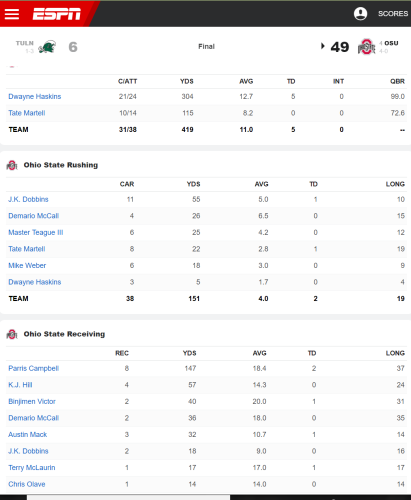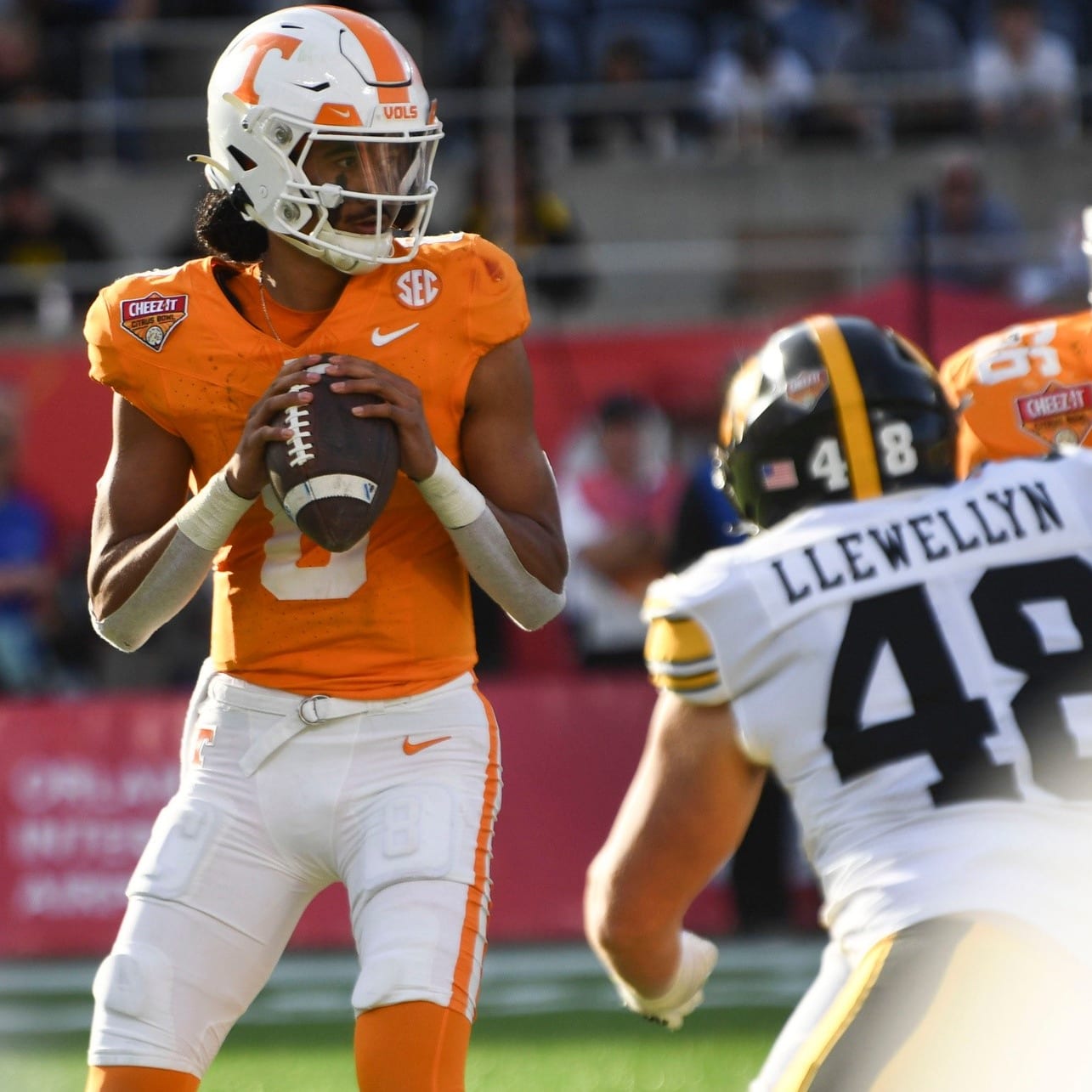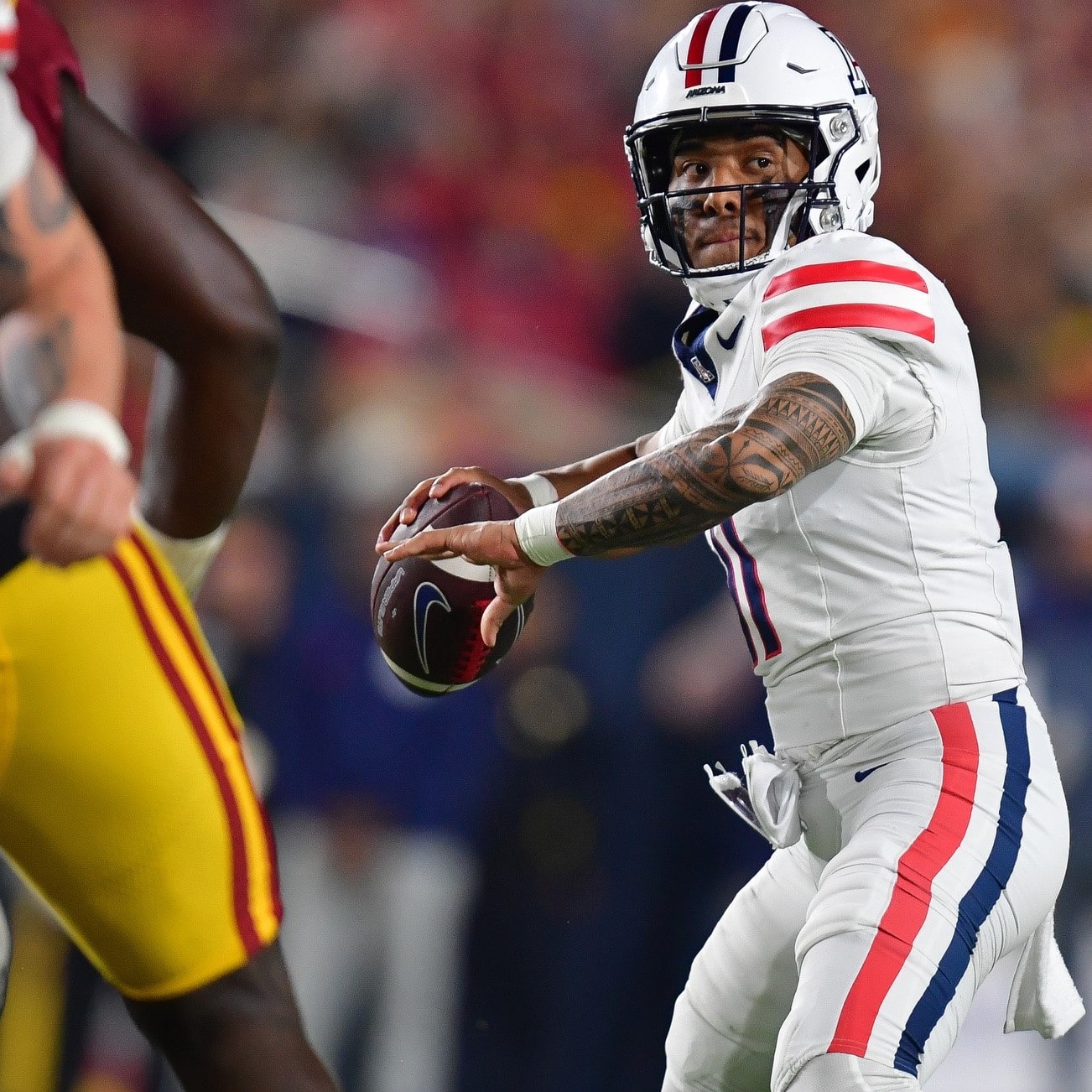This article is part of our DFS College Football 101 series.
College football's reintroduction to DraftKings last season was monumental for public interest in the sport from a fantasy perspective and gave us all a little extra incentive to pay attention on Saturdays. And Thursdays. And Fridays. And sometimes on Tuesday and Wednesday.
A lot changed in the two years that college football left the daily fantasy landscape. The fantasy community got sharper. The data got better. The information became more accessible. All of those positive developments made for a better overall DFS game with sharper fields.
My goal here is to help get you started down the right path with another season just around the corner. I'll talk about contest selection and lineup construction, along with other strategic pillars to get you better prepared for when toe meets rubber.
Lineup Construction
Following Vegas
When analyzing a slate, the first step I take is to look at the implied totals and the spreads. This is the quickest way to get Vegas' scoring expectation for each team on a given slate. Below is a sample from Week 4 of last season.
| Team | Opponent | H/A | O/U | Spread | Implied Points |
| Ohio State | Tulane | H | 68.5 | -37 | 52.75 |
| Alabama | Texas A&M | H | 61 | -26 | 43.50 |
| Georgia | Missouri | A | 64.5 | -14 | 39.25 |
| West Virginia | Kansas State | H | 60.5 | -16 | 38.25 |
| Boston College | Purdue | A | 65 | -7 | 36.00 |
| Michigan | Nebraska | H | 50.5 | -18 | 34.25 |
| Notre Dame | Wake Forest | A | 60 | -7 | 33.50 |
| Clemson | Georgia Tech | A | 51 | -15.5 | 33.25 |
| Baylor | Kansas | H | 56 | -7.5 | 31.75 |
| Purdue | Boston |
College football's reintroduction to DraftKings last season was monumental for public interest in the sport from a fantasy perspective and gave us all a little extra incentive to pay attention on Saturdays. And Thursdays. And Fridays. And sometimes on Tuesday and Wednesday.
A lot changed in the two years that college football left the daily fantasy landscape. The fantasy community got sharper. The data got better. The information became more accessible. All of those positive developments made for a better overall DFS game with sharper fields.
My goal here is to help get you started down the right path with another season just around the corner. I'll talk about contest selection and lineup construction, along with other strategic pillars to get you better prepared for when toe meets rubber.
Lineup Construction
Following Vegas
When analyzing a slate, the first step I take is to look at the implied totals and the spreads. This is the quickest way to get Vegas' scoring expectation for each team on a given slate. Below is a sample from Week 4 of last season.
| Team | Opponent | H/A | O/U | Spread | Implied Points |
| Ohio State | Tulane | H | 68.5 | -37 | 52.75 |
| Alabama | Texas A&M | H | 61 | -26 | 43.50 |
| Georgia | Missouri | A | 64.5 | -14 | 39.25 |
| West Virginia | Kansas State | H | 60.5 | -16 | 38.25 |
| Boston College | Purdue | A | 65 | -7 | 36.00 |
| Michigan | Nebraska | H | 50.5 | -18 | 34.25 |
| Notre Dame | Wake Forest | A | 60 | -7 | 33.50 |
| Clemson | Georgia Tech | A | 51 | -15.5 | 33.25 |
| Baylor | Kansas | H | 56 | -7.5 | 31.75 |
| Purdue | Boston College | H | 65 | 7 | 29.00 |
| Wake Forest | Notre Dame | H | 60 | 7 | 26.50 |
| Missouri | Georgia | H | 64.5 | 14 | 25.25 |
| Pittsburgh | North Carolina | A | 47.5 | -3 | 25.25 |
| Kansas | Baylor | A | 56 | 7.5 | 24.25 |
| North Carolina | Pittsburgh | H | 47.5 | 3 | 22.25 |
| Kansas State | West Virginia | A | 60.5 | 16 | 22.25 |
| Georgia Tech | Clemson | H | 51 | 15.5 | 17.75 |
| Texas A&M | Alabama | A | 61 | 26 | 17.50 |
| Nebraska | Michigan | A | 50.5 | 18 | 16.25 |
| Tulane | Ohio State | A | 68.5 | 37 | 15.75 |
As you can see, breaking down those factors immediately gives you an idea of teams to target and avoid. Generally, you want to avoid games with lower over/unders and teams with lower implied points. Put another way, if you loaded up on the Tide, Buckeyes, Bulldogs, and 'Neers, you probably had yourself pointed in the right direction.
The rub is that a massive favorite, like Ohio State in this example, can often take its foot off the gas in the second half and still cruise to hitting that implied total or close to it. Ohio State scored 49 points in that game, and while there were some big performances along the way, they weren't optimized and the wealth was spread around in a way you wouldn't see in a more competitive game.
If you had Haskins, you weren't mad that Tate Martell (hey, he's been in the news, huh?) got in at garbage time. Haskins still got his. If you had J.K. Dobbins, you allocated a significant amount of your salary to a back who got 11 carries for 55 yards and a score. Your lineup might still be salvageable, but your odds of finishing near the top of your contest have taken a massive hit. Same can be said for those who picked the wrong Buckeye receiver and were saddled with Terry McLaurin returning next to no value.

Point being that targeting teams with high implied totals expected to be ensconced in competitive games -- let's say two-touchdown favorites or less -- is often a good place to start as far as stacking is concerned. Stacking skill position players from teams expected to blow out their opponents can result in sub-optimal results.
Another example from last season would be Alabama's Jerry Jeudy. The talent and the per-target production were off the charts. He averaged 12.8 YPT during the regular season and scored touchdowns on 13 percent of his targets (holy...) but he also had just four games with more than five catches. On a site like DraftKings where it's a full point per reception, losing out on volume can sting. There were 115 other receivers in FBS that averaged more targets per game than Jeudy did a year ago. Of course, Jeudy still managed to be the 20th most productive receiver in standard scoring despite that lack of volume. So if you went with Jeudy on DraftKings over some of the more high-target volume receivers, you left yourself open to leaving points on the table.
Tempo, Tempo, Tempo
Part of what makes college fantasy football so great is the sheer amount of points we see from teams and, by extension, from the players we roster. We don't get implied totals in the 50s in the NFL and we don't see our top receivers average nearly 20 fantasy points per game. A big reason behind that is the volume that comes from the high-tempo offenses in the college game.
A fast-paced team in the NFL might run 70 plays per game while that number would rank 84th in the nation in the college realm. Targeting teams that run a higher than average play count is advantageous in both college and NFL, but there's a far wider range in that regard when it comes to the college game, making it easy to identify and target the offenses that play fast.
Last year, East Carolina ran 84.0 plays per game, ranking third in the nation. Now, it wasn't an efficient 84.0 plays per game -- the Pirates ranked 115th in yards per play -- but hey, volume is king. The volume made up for the lack of efficiency and made the Pirates a DFS staple. Quarterback Holton Ahlers completed under 50 percent of his passes and averaged under 7.0 yards per attempt but still managed to gain fantasy relevance when healthy because he was throwing such a high volume of passes that the numbers eventually piled up. Same with ECU's top receiver, Trevon Brown, who averaged a paltry 6.45 YPT but saw 174 targets over the course of the season, allowing volume to win out over the inefficient per-target production.
On the other side of the coin, teams who play a ball-control, drag-you-into-the-mud style of football are DFS kryptonite, even if you aren't using players from a team that fits that description. Guilt by association, man.
Army, famous for its option offense, actually ran close to the FBS average in plays per game a year ago. But it was also able to tank Oklahoma's offense last season. Not because of its defense, but because of its own offensive philosophy.
The Oklahoma-Army game from last season is the perfect example. Now, Oklahoma wasn't exactly a max-tempo team over the course of the season and actually ran less plays on a per-game basis than Army. But the Sooners could giddy up when they wanted to and they led the nation in yards per play and yards per game.
But what happened when the Sooners ran into Army? Well, they posted season-lows in plays and yards despite averaging a strong 8.8 yards per play. That's because Army played keep away, possessing the ball for 44:41. It's an extreme example, of course, but it underlines the point that you need to aim high with tempo and you can avoid that by avoiding opposing teams that can drain the clock.
TL;DR: Don't target teams that are going up against low-tempo, high time-of-possession squads. It will limit your projections for play volume and game script, and everything else will flow in the wrong direction from there.
Contest Selection: GPPs versus Cash Games
Cash Games is a sort of catch-all term that applies to contests like 50/50s, head-to-heads, and double-ups. In these types of contests, your odds at finishing in a payout position are high compared to GPPs, but the payouts are usually double the entry fee at best.
So, if you were to enter a $10 50/50 on DraftKings, you just have to finish in the 51st percentile of the field in order to cash. However, everyone who finishes at that mark and above wins the same amount of money. In this case, cashing in a $10 50/50 would result an $18 payout, or an $8 net gain. As our Jerry Donabedian so deftly put it in his DFS Football: How To Play on DraftKings (NFL) article, "A double-up contest does exactly what its name implies, but it only pays out 42-46 percent of the field to leave room for the rake."
A GPP stands for a contest with a guaranteed prize pool. These are the types of contests where you see the winners on TV holding a big check for an even bigger sum of money. Your odds of cashing are drastically slimmed down compared to a cash game contest, but the allure is a much larger payout if your lineup(s) perform well.
The type of contest you choose informs the way you want to approach your lineup build.
In cash games, you're not shooting for the moon. You just want to be better than ~ half the entrants. This allows you to go after 'safer' players with a high floor. There's no need to go after the freshman wideout who wasn't even on this week's two-deep depth chart in this type of format. 50/50s and the like allow you to build a quality lineup without having to dip into the minimum-priced part of the player pool.
Tournaments are a different animal. Tournaments are about separating yourself from the pack. It's not just about having a high point total, although that is the ultimate goal. It's about doing it with a lineup that no one else has.
For instance, when there's a backup running back who gets elevated to a starting role on Friday (aka after prices are released), that player suddenly becomes an elite option, someone you'd want in your lineup. While that is the case, don't think you're separating yourself from the pack by using that player, because everyone else will have caught wind of that news and that player will have a high ownership percentage.
This is why a successful tournament lineup will often have a "risky" play in there, someone who has a low ownership percentage. For instance, if you can identify a near-minimum salary player who has a chance to see more playing time than usual and he returns 5x or 6x value, you've likely separated yourself from the field while also climbing the standings.
Scoring System
| Offense | Point Values |
|---|---|
| Passing Touchdown | +4 Pts |
| 25 Passing Yards | +1 Pt (+.04 Pts/Yards) |
| 300+ Yard Passing Game | +3 Pts |
| Interception | -1 Pt |
| Rushing Touchdown | +6 Pts |
| 10 Rushing Yards | +1 Pt (+0.1 Pts/Yard) |
| 100+ Yard Rushing Game | +3 Pts |
| Receiving Touchdown | +6 Pts |
| 10 Receiving Yards | +1 Pt (+.01 Pts/Yard) |
| 100+ Receiving Yard Game | +3 Pts |
| Reception | +1 Pt |
| Punt/Kickoff/FG Return for TD | +6 Pts |
| Fumble Lost | -1 Pt |
| 2 Point Conversion (Pass, Run, or Catch | +2 Pts |
| Offensive Fumble Recovery TD | +6 Pts |
As mentioned in the first section, the full-point per reception is a massive factor when playing on DraftKings. This not only points us in the direction of which receivers to use, but it's also useful in identifying and separating out running back targets. Last season, Washington State's James Williams was an average runner who not only had a massive workload at the goal line (12 touchdowns), but he was also heavily involved in the Cougs' passing game. He lapped the field in targets among running backs, seeing 86 targets and catching 76 of them. Even his five-yard receptions were as good as another running back's 15-yard rush. Stud running backs with touchdown upside are always worthy of being your RB1, but when you're looking at RB2's at a lower price point, their role in the passing game should be a tiebreaker.
DraftKings as we know it today also has a SUPERFLEX spot, which essentially means we get to make two-quarterback lineups. Quarterbacks tend to be among the most expensive pieces on the board, so rostering two quarterbacks requires some concessions at other positions. It's worth it, however, as even an average quarterback tends to outscore an upper-echelon running back on a given week.
Take this as a starting point for dipping your toes into the DraftKings college football waters. Throughout the season, I'll be posting slate-specific articles with plays and fades every week. We also have great research tools on the site that help decision making.
I cannot say enough about our team trends page, which gives you a breakdown of where the targets and touches are going for each FBS team. We also have a great stats page, which covers all your bases and includes vital stats like targets. We also have top-notch breaking news and injury data to help you make the most informed decisions possible.
Here's to another great season in 2019. Cheers!










